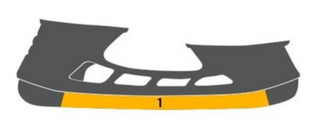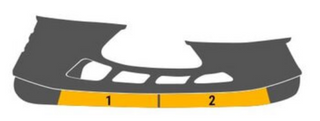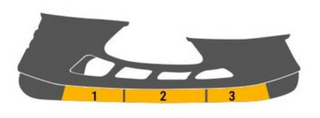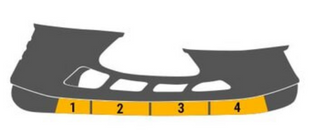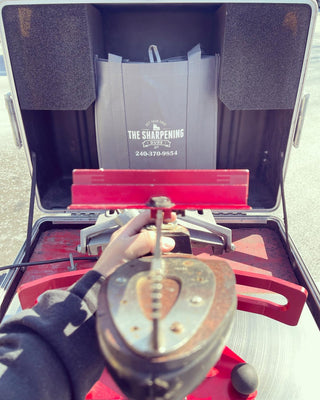
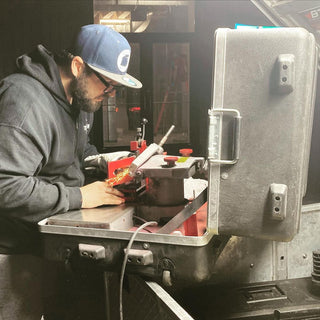
BETTER QUALITY = BETTER PERFORMANCE
Edges 101
Class is in session!
We're going to cover everything about edges. From traditional Radius of Hollow (ROH or "Standard Cuts") to Flat Bottom V (FBV), and SPARX's "Fire". We'll cover it all here!
Radius of Hollow (ROH or " Traditional Cut")
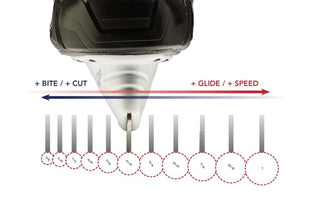
What is a Radius of Hollow (ROH)? That's a question we get asked every day at The Sharpening Dude. To put it simply, ROH is the official term used to describe the "cut" you get on the bottom of your skate, and it is not to be confused with Profile which is covered below.
So, what's the big deal about ROH? In basic terms, it's a portion of a circle used to create the "U" shape on the bottom of your blade. The small the measurement, the more bite or grip you have on the ice. The larger the measurement, the more glide you have. Based on that sentence, most folks think they need to jump right into a large hollow to have as much speed as possible, but as in most things in life, it's all about balance. You're sorely mistaken if you decide to go for the largest hollow, thinking you'll be sprinting around the rink like Connor McDavid. You'll cause yourself not to be able to get all the force from your leg muscles into the blades and push you forward. Conversely, if you think you're going to corner like a Formula 1 racer in the corners with a keen bite edge, you might not be able to stop correctly and smash your face against the boards.
No, just like life, we need balance. Not too much bite, not too much glide. So the question you might ask is, what's the best balance for me? Well, that all depends on the skater. The most used rule of thumb is the bigger you are, the wider your ROH. This is not necessarily a set-in-stone fact. I prefer to converse with customers based on their experience, what ROHs they've used previously, and where they've sharpened their skates. I can deduce an ROH that might work for them with these questions.
So what are the measurements, and what do they mean? We use the measurement of a circle's radius. If you took the edges of your skates and lined up enough of them perfectly, they would make a perfect circle (if they've been appropriately sharpened!), and that circle can be measured in portions of an inch.
The range we use from smallest to largest is as follows:
3/8”
7/16”
1/2"
9/16”
5/8”
11/16”
3/4"
13/16”
7/8”
15/16”
1”
1-1/4”
1-5/16”
1-3/8”
ETC.
The Sharpening Dude's standard for hockey is 1/2" for skaters (forwards/defense) and 3/4" for goalies. Figure skaters have their own standards; that page can be found in the Elegance Unmatched section. Spring/Summer is the best time to experiment with ROH, and try going broader or more narrow and see what fits you best.
Now, if you're a brand new skater and coming in for the first time, I am going to put you on a ½" ROH. This is probably the most common starting point for everyone. I, at 250 lbs, still skate on a ½" cause its what fits me the best. Some players change their ROH based on the rink they play at and the ice conditions. The bottom line is that there are so many factors on ROH that we sharpeners like to discuss with each person to find the ROH that fits them best. Stop by today, see The Sharpening Dude, and figure out what's best for you!
Flat Bottom V
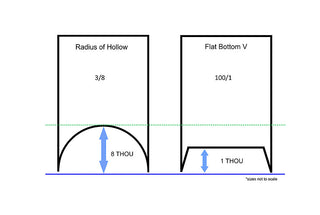
Flat Bottom V (FBV) is a newer edge style for your skates. Instead of creating a U shape, it makes more of a V shape with the center point being a bit wider image it looks like this \_/. This relatively new type of sharpening was invented by Blackstone® Sports, one of the largest and best-known names in the skate sharpening world. FBV numbers correspond to the ratio between the flat portion's width and the V-wall's height. The first number is width which helps understand the grip. The larger the number, the more grip you have. The second number is the flat portion; the larger the number, the more glide you get. Again, this is all relative to balance, and there's no substitution for experience.
There are always advantages and disadvantages to each type of sharpening. An FBV cut may cause a skater to experience better glide and control but is also susceptible to more significant issues when experiencing collision on the ice or stepping on something off the ice. When a chip forms in an FBV blade, it tends to break off in chunks vs. smaller knicks observed in classic Radius of Hollow (ROH). When the larger sections of blade chip and break off, skaters experience an inability to skate afterward and require a change of blades or having to get them immediately sharpened instead of "battling through the rest of the game."
Do not be discouraged from trying an FBV sharpening. As with all things, it comes down to what you're feeling on the ice. There is no cookie cutter method to make someone an elite skater; it takes time, practice, and experimentation to achieve goals. I've made a list of FBV cuts and their corresponding ROH.
The Sharpening Dude does not recommend ROH or FBV. Instead we try our best through discussion and observation to see what may work for each individual skater. FBV's have a guide similar to ROH and can be found below. If you still find yourself confused or left with additional questions, we find it's best just to reach out and ask.
We offer FBV cuts in the following options.
100/75 = 3/8”
95/1 & 95/75 = 7/16”
100/50 = 1/2"
92/75 & 98/50 = 9/16”
90/1 = 5/8”
85/1 & 92/50 = 11/16”
90/75 & 88/50 = 3/4"
85/50 = 13/16”
95/50 = 7/8”
85/75 & 80/1 = 15/16”
90/50 = 1”
80/75 = 1 1/8”
82/50 = 1 1/4"
80/50 = 1 3/8”
75/50 = 1 1/2"
72/50 = 1 5/8”
70/50 = 1 3/4"
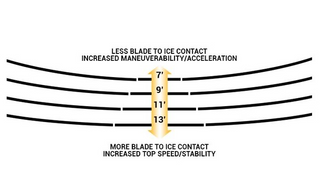
Profiling
Beware, this subject can get lengthy and confusing. If you find yourself lost, don't worry, The Sharpening Dude's got your back!
What is a profile?
A skates profile is the physical shape of the blade measured from toe to heel. It’s a bit more complicated than that, but that’s the gist of it. The shape of the blade is measured in feet, not fractions of an inch like ROH, as discussed above. The curvature of the blade comes in contact with the ice. In the beginning, skates had a single radius profile measured in feet. The most common types from then are still found today. Most steel that comes on your skates is in a single radius when you buy them. The typical profiles are 7’, 9’, 10’, 11’, 13’, and 15’, and goalies use 28’, 30’, or an extremely flat profile known as 4mm flat.
Other than single radius profiles, we have some companies trademarked their process and profiling names. The most common ones are ProSharp (purchased by Bauer in 2021), CagOne, EZ Sharp, and Dupliskate. Of those listed ProSharp and CagOne are the most common. What’s the difference?
Honestly, it has more to do with market saturation than anything. ProSharp is originally from Sweden. Bauer’s recent acquisition of ProSharp has made these profiles much more popular due to the marketing and overall popularity of Bauer. ProSharp also offers a comprehensive array of profiles. ProSharp machines can put up to 4 separate profiles onto one blade. This is demonstrated in the pictures below. Their profiles include the single-radius, dual-radii, Zuperior (3 profiles on one blade), and Quad (4 profiles on one blade).
“Which one is best for me?” is a question I get asked multiple times daily. This is an extended conversation we like to have with our customers, as you can imagine how technical it gets. The basics are laid out as such. Single radius and dual-radii are the most common entry-level profiles for customizing your game. From there, we move on to the Zuperior, which is made for speed and acceleration. Quad profiles are created for power. Remember, power does not equal speed. Power equals power when you need more grip on the ice for laying out devastating hits or going into the boards for battles over the puck. The bottom line is to start the conversation with The Sharpening Dude so we can guide and help you be your best.
CagOne is a brand similar to ProSharp, offering similar profiles. Please get in touch with us if you have specific questions about each type of profile.

